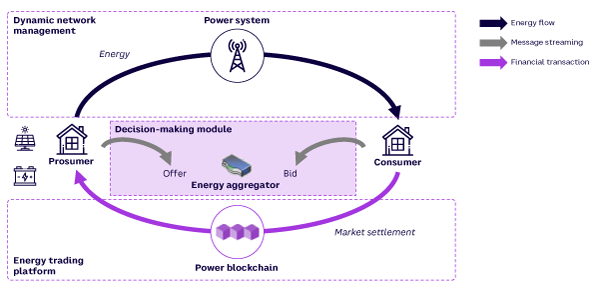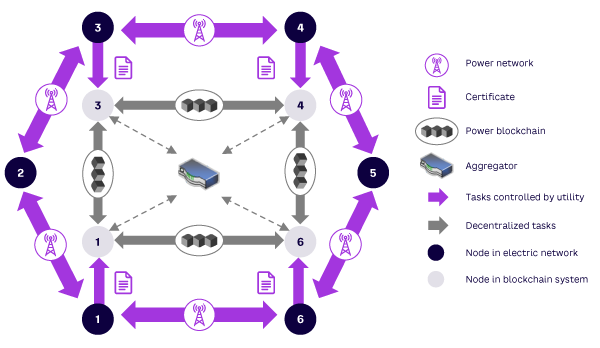AMPLIFY VOL. 36, NO. 9

Decarbonization, decentralization, digitalization, and democratization are shaping the future of energy systems. Blockchain is a powerful technology that can help us transition to a more sustainable, resilient, efficient, and equitable energy future. However, this transition involves a number of pain points that must be considered by senior energy and utilities executives.
Grid decentralization is the result of: (1) the current focus on resilience and (2) the increasing number of smart devices, microgrids, electric vehicles (EVs), and distributed energy resources (DERs) being integrated into the power grid. The Institute for Electric Innovation (IEI) reports that more than 114 million smart meters were deployed in the US as of 2021 and expects that number to reach 135 million by the end of 2025.1 The International Energy Agency (IEA) forecasts a global EV deployment of 40 to 70 million by 2025, reaching between 120 and 160 million by 2030.2
These trends indicate the importance of investing in grid decentralization to facilitate scalable operational capabilities. Blockchain technology has the potential to facilitate this process in energy systems. However, there are at least three pain points that senior executives in utility companies will need to address to ensure a smooth transition to a decentralized grid:
-
Transactive energy infrastructure
-
Operational capabilities
-
Decentralized decision-making processes
Transactive Energy Infrastructure
Blockchain technology can be used to build the transactive energy infrastructure needed for grid decentralization.3 Figure 1 shows a decentralized grid system architecture.4 Operational information and processes are carried out by an energy aggregator, and market settlements are carried out through a blockchain platform. Blockchain can facilitate a transaction infrastructure for peer-to-peer (P2P) energy trading across the grid, but a robust collaboration plan involving all aggregators will be needed.

With this type of architecture, no intermediary is required to provide security support or keep a transaction ledger (in conventional centralized grids, these tasks are performed by the system operator). With blockchain’s distributed digital ledger, a broad range of data (from financial transactions to power system signals) are stored in a package called a “block.” These blocks are identified by a cryptographic characteristic called a “hash” and are connected in chronological order. The previous block hash is included along with the current hash, literally linking the blocks and creating a chain (hence, “blockchain”).
A process called “consensus mechanism” prevents falsified data from entering the chain. Consensus mechanism guarantees the correctness of the latest block added to the chain to all nodes in the chain. That action is called “mining,” and the nodes that carry out this task are called “miners.” The most common consensus mechanisms are proof of work (PoW), proof of stake (PoS), practical byzantine fault tolerance, proof of authority (PoA), and proof of elapsed time (PoET).
In “Conceptual Design of a Consensus Mechanism for Renewable Energy Markets on Blockchain,” we proposed a proof of concept (PoC) for a novel consensus algorithm, namely proof of reserve (PoR) designed for P2P renewable energy transaction on blockchain platforms.5 PoR is a combination of PoS and PoW algorithms. It attempts to avoid the high computational power needed for PoW while allowing as many nodes as possible to participate in the mining process. It also maintains the voting procedure and higher scalability potential of PoS.
Large-scale implementation of blockchains to facilitate transactive energy infrastructure requires significant investment and new regulatory frameworks. The investment includes both the cost of blockchain platform deployment and the cost of required upgrades to smart meters, communication protocols, data-storage devices, and other power grid components.
Senior utilities executives should consider the decentralization process not only as grid-modernization project, but also as a capital project in which investment decisions should be justified via expected future cash flows and the required ROI during the project lifecycle.
Operational Capabilities
Blockchain can provide a secure, distributed system architecture to facilitate grid decentralization. However, limitations on the number of transactions, latency, and storage capacity remain serious hurdles for large-scale implementations of this technology. There is promising work underway to address this issue by increasing the block size, sharding, forking, and developing new blockchain architecture.
Another hurdle is the need for more efficient consensus mechanisms. Current consensus mechanisms suffer from high energy consumption and the risk of monopoly formation on the blockchain. PoW in aggregate consumes as much electric power as the country of Denmark.6
Consensus mechanisms like PoS were introduced to overcome this issue, but they put blockchains at risk of being monopolized by bad actors, weakening the decentralization objectives of the system. The creation of consensus mechanisms that offer more energy savings, higher levels of decentralization, and improved scalability and security is a prerequisite to creating a large-scale, fully decentralized grid.
The current state of blockchain interoperability (defined as the ability of blockchain platforms to exchange information with each other) also poses a challenge to efficient operations of such decentralized energy systems.7 It is expected that other blockchain applications (e.g., in banking) required to interact with energy blockchains will emerge in the future. To enable that interaction, more capabilities for cross-chain interoperability should be developed to facilitate the future interoperability requirements between different blockchain platforms.
Senior utilities executives should consider the existing technical limitations of blockchain technology when reviewing the functional requirements of their grid-decentralization strategy.
Decentralized Decision-Making Processes
In a decentralized power grid enabled by blockchain, the decision-making process is distributed among network participants (or decision agents in this context). Each participant has a certain level of authority in a distributed framework that replaces the centralized decision-making process used in conventional systems with a cooperative decision-making process.
Game theoretic decision models and cooperative decision models, such as decentralized, partially observable Markov decision processes, replace decision theoretic models that are primarily focused on unilateral or one-player decisions. Despite this decision distribution, there still is a need for a single entity to oversee various operational configurations, such as power dispatch, frequency control, and voltage control. This can pose a challenge for governance of the decentralized system. Decision processes are, to a large extent, distributed across the grid, but some grid operations are still centralized in nature.8
Even if these central operations aspects are automated through autonomous software agents, there still is a need for a single entity to maintain the stability of the system and provide the required network maintenance and support services.
Senior utilities executives should pay special attention to the design of system governance structure and policies before transitioning to a completely decentralized grid.
The Role of Utilities in Transitioning to the Grid of the Future
Electric power distribution networks will become more decentralized and autonomous in the foreseeable future, but this will likely be partial rather than full scale. Existing decentralization technologies, including blockchain, are still primarily focused on facilitating the settlement processes and keeping a distributed ledger of P2P transactions. Important parts of system operations (e.g., power flow planning, voltage stability, frequency control, transient stability, and other dynamic network management activities) should still be performed by third-party intermediaries, such as utilities and distribution system operators.
A hybrid decentralization architecture is a more plausible scenario for distribution network system design, as shown in Figure 2. The purple arrows represent the information flow for the tasks performed by the utility; the gray arrows depict the information flow for decentralized tasks. The solid gray arrows represent financial transactions on the blockchain, and the dashed gray arrows show the message-streaming activities. In this example, blockchain nodes 1, 3, 4, and 6 are authorized by the utility to engage in P2P transactions. Users submit bids and offers through this channel to the aggregator, and the aggregator notifies them about transaction decisions based on the underlying market rules.

Some utilities may be able to monetize their platform by offering infrastructure as a service (IaaS) to consumers and prosumers, providing system maintenance and other support activities. For instance, the power dispatch from prosumers to consumers can be facilitated on their blockchain through game theoretic models programmed into smart contracts in which both prosumers and consumers are considered as passive loads in their power-flow studies. As part of their business model, utilities can perform power-flow studies to determine the output of the utility-owned generators, power purchases, voltage levels, and reactive power decisions in return for the per-transaction commissions they receive.
Utilities can also play a crucial role in maintaining system stability. For example, they can be in charge of P2P transaction modifications required due to system-frequency or voltage-level deviations and compensate the prosumers and consumers involved in those unfulfilled transactions.
A private blockchain (an invitation-only platform governed by a single entity) can be a reliable solution for decentralization of power-distribution networks. In this scenario, the administrator manages user access in the system using a private key. Utilities act as a system administrator, sending invitations or granting permission to consumers and prosumers to join the transactive energy platform.
Utilities can also certify authorized users to monitor fraudulent activities on the platform and keep out bad actors. That may include eliminating such users from participating in the consensus mechanism, denying access to the platform, and other disciplinary measures based on the gravity of the noncompliance. In addition, utilities can determine the blockchain’s operational policies and governance structure. That may include decisions on block size and structure, consensus mechanism, smart contract configurations, incentive design, and transaction structure.
In our view, as the underlying concepts, system design, technologies, and business models related to the decentralized grid evolve, new functions will emerge for utilities to fulfill, and some current functions can be outsourced to autonomous systems and new players. What should not change, however, is the central role of utilities in the decentralized grid.
Blockchains & Interoperable Microgrids
Modern energy systems are increasingly integrating independent, local, decentralized power systems known as “microgrids.” Microgrids offer better operational efficiency and higher resilience than conventional power systems. Further benefits can be obtained through a cooperative microgrid ecosystem comprising clusters of multiple microgrids.
In these collaborative ecosystems, each microgrid can supply loads from the excess generation capacity of other microgrids and sell its power surplus to other microgrids. Achieving this requires a system architecture that facilitates cooperation among microgrids by providing appropriate cross-market rules and transaction infrastructure.9
Blockchain has the potential to decentralize systems in various applications, including power-distribution networks, providing a secure platform for optimal network operations. In addition, blockchain can facilitate information sharing and transactions among blockchain platforms without the need for intermediaries. These capabilities can be leveraged for implementation of decentralized distribution networks with multiple interoperable microgrids (IMs).
With this type of architecture, users can view the power surplus and electricity rates in other microgrids, send bids, receive offers, and complete energy transactions on the blockchain using designated market rules. This provides a transparent infrastructure for monitoring the carbon footprint and share of renewables in the energy composition of each microgrid; it can even be used to establish market mechanisms for carbon pricing.
IMs can enable better ancillary service provisions and improved dynamic management of the network by providing better access to other microgrid resources. IMs also bring resilience to the network by adding redundancy to the system topology due to their decentralized architecture. This has the potential to reduce operational costs and increase the reliability and efficiency of power-distribution networks.
However, IMs can also create challenges for decentralized distribution networks. First, the interoperability of the transaction infrastructure must be accompanied by well-designed, cross-market rules to facilitate marketplace interoperability. Second, effective governance structure and standard protocols must be developed to ensure the compatibility of various consensus mechanisms across platforms. Third, there are several technical challenges, including ensuring transaction atomicity, improving transaction speed, securing data transmission, ensuring universality of cross-chain protocols, and implementing user- and developer-friendliness of the blockchain.
We are encouraged by recent technological developments in the interoperability of blockchains and the decentralization of distribution networks.10 In our view, interoperable microgrids enabled by blockchain can offer more choices to consumers, improve market efficiency by eliminating middlemen, increase resilience by decentralizing the network topology, and enable new marketplaces, such as carbon markets.
IMs should be part of the grand strategy of the utilities for decarbonization, decentralization, and digitalization of the smart grid.
Conclusion
Blockchain is a powerful enabling technology for decarbonization, decentralization, digitalization, and democratization of our future energy systems. Although blockchain has potential in a wide spectrum of applications in the energy and utilities industry, several challenges and limitations must be addressed before its full implementation into grid operations.
Senior energy and utility executives should acknowledge these limitations as they develop business strategies while watching for technological developments that can facilitate successful adoption of this technology. As the industry undergoes a gradual but fundamental restructuring into a more competitive market, advancement in blockchain technology can be a game changer for utilities competing in increasingly decentralized, highly fragmented energy markets.
References
1 “Smart Meters at a Glance.” The Edison Foundation Institute for Electric Innovation, accessed September 2023.
2 “Electric Vehicles and Electricity.” The Oxford Institute for Energy Studies, June 2018.
3 “Transactive Energy: An Overview.” National Institute of Standards and Technology (NIST) Smart Grid Group, 19 April 2017.
4 Choobineh, Moein, et al. “Blockchain Technology in Energy Systems: A State-of-the-Art Review.” IET Blockchain, Vol. 3, No. 1, March 2023.
5 Arabnya, Ali, et al. “Conceptual Design of a Consensus Mechanism for Renewable Energy Markets on Blockchain.” Proceedings from The Grid of the Future Symposium, University of Denver/ComEd/CIGRE, Providence, Rhode Island, USA, 18 October 2021.
6 Andoni, Merlinda, et al. “Blockchain Technology in the Energy Sector: A Systematic Review of Challenges and Opportunities.” Renewable and Sustainable Energy Reviews, Vol. 100, February 2019.
7 Choobineh, Moein, et al. “Energy Innovations Through Blockchain: Challenges, Opportunities, and the Road Ahead.” The Electricity Journal, Vol. 35, No. 1, January–February 2022.
8 Choobineh, Moein, et al. “Game-Theoretic Peer to Peer Solar Energy Trading on Blockchain-Based Transaction Infrastructure.” e-Prime: Advances in Electrical Engineering, Electronics and Energy, Vol. 5, September 2023.
9 Khodaei, Amin, and Ali Arabnya. The Economics of Microgrids. Wiley, 2023.
10 Choobineh et al. (see 4).




